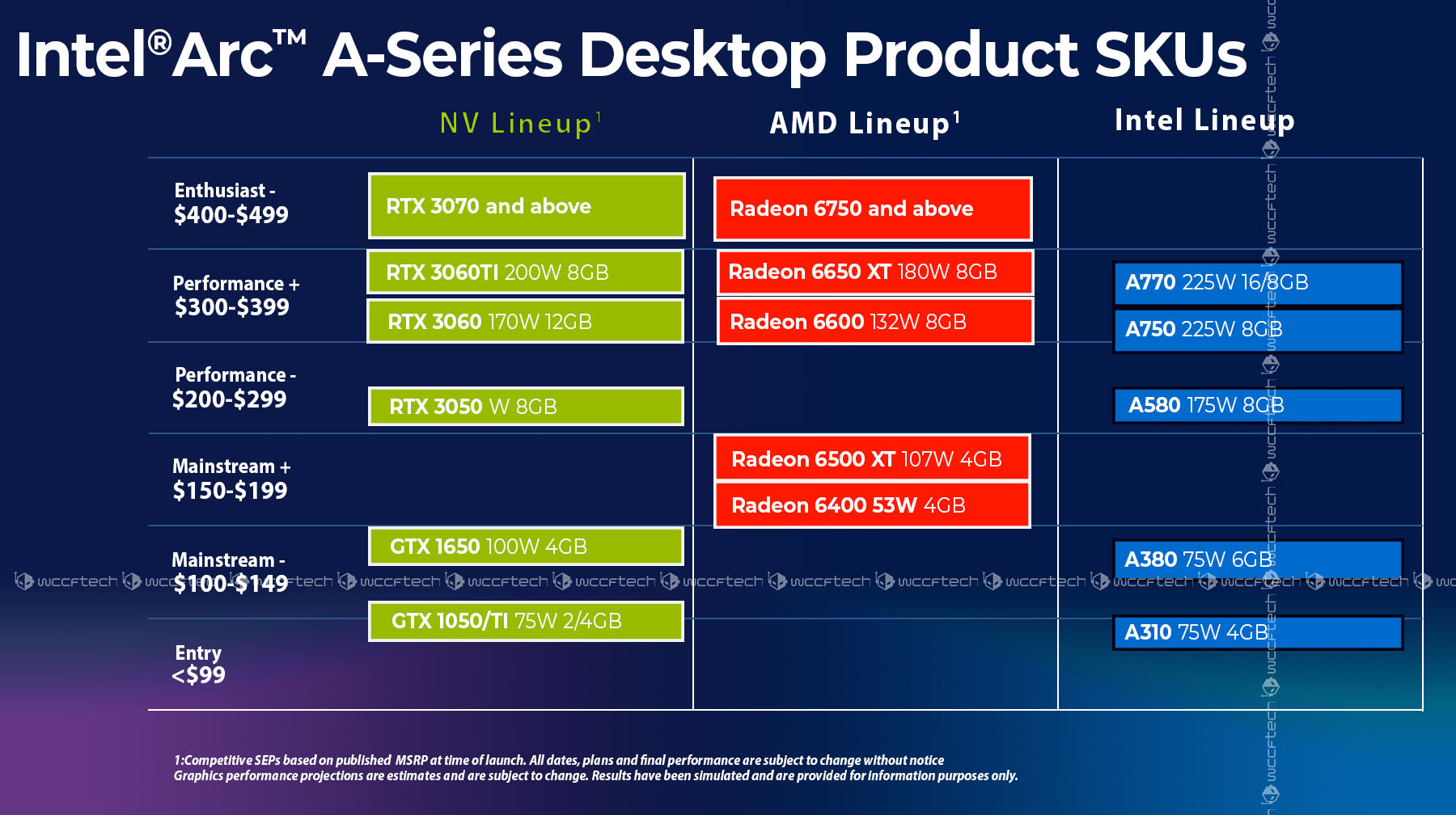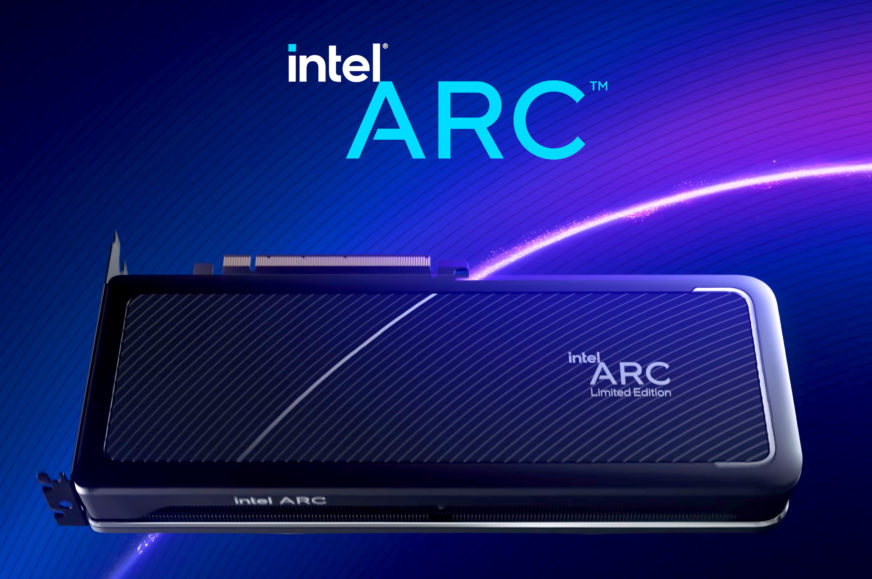Alchemist generation Arc GPU lineup for desktop gets clearer, A750 is a more powerful configuration than we thought
More information is gradually coming in on Intel’s first generation of discrete gaming GPUs, the Arc graphics cards. Intel recently revealed the performance of Arc A750, said to outperform GeForce RTX 3060 cards. It won’t be the fastest SKU, now Intel began showcasing the more powerful A770 model. We now have more detail, and it seems that A770 won’t push the performance as high above the A750 card as we had hoped.
New details about these graphics is coming from multiple sources. The first one we’ll look at is a slide published by WCCFtech that gives an overview of all the models of this generation of Arc graphics. In the past we ran a story that there could be up to eight different desktop Arc cards, but it looks like the number of SKUs will be smaller in the end – just five.
Starting from the bottom, Intel is preparing two 75 W models in the low end. The first Arc A380 has already been officially released (but only in China) and we know it pretty well already – it’s a card with a full version of the ACM-G11 die with 1024 shaders / 8 Xe Cores and 6 GB of memory, which should cost about 130 to 140 USD.
What’s new is that Intel will also sell a weaker and cheaper version called Arc A310 that could hopefully cost under 100 USD. This is a card with 4 GB of memory (which means a 64-bit bus). We don’t know the other specs for sure, but it will probably have the GPU stripped down to 75 % of the compute units, i.e. 768 shaders / 6 Xe Cores, as that’s a planned configuration that has appeared in leaks previously. While the Arc A380 is supposed to compete with Nvidia’s GeForce GTX 1650, the A310 will have roughly the performance of the old GeForce GTX 1050 Ti, according to Intel.

A little higher up the ladder, Intel will be offering the “Arc 5” class card Arc A580. This should be a SKU based on the more powerful ACM-G10 GPU, but in a configuration using various lower-bin and harvested chips, with practically only half of the GPU being active. The new slide only states that the card will have 8 GB of memory (probably on a 128-bit bus) and a 175 W TDP. According to older information, it should hopefully have 2048 shaders / 16 Xe Cores (while the full-fledged chip has 32 Xe Cores). The price, according to the slide, could hopefully be between 250 and 300 USD and the performance around the GeForce RTX 3050. However, this card will probably come out later than the most interesting higher-tier “Arc 7” models, which we’re going to discuss now.
More: Another Intel Arc GPU delay. They will only come out in China, only low end for now
Arc A780 does not exist, the top model is Arc A770
According to the slide, the price of these graphics cards, which will be Intel’s highest-performance offers in the Arc lineup, should be between 300 and 400 USD. The are two models planned, A750 and A770. Earlier, there was some talk of an A780 card, but Intel has now said that this was incorrect information and no such SKU was ever planned. This means that the top model will be the Arc A770. This should be a card with a fully active ACM-G10 chip, which will have 32 Xe Cores / 4096 shaders (or 512 EUs). TDP is 225 W according to the slide and the card can have either 8 GB or 16 GB of memory (larger capacity will probably cost more).
Intel has showcased this graphics card in a video on the Linus Tech Tips channel, but without showing the exact performance so far. However, this video shows that the base clock speed of the GPU should be 2500 MHz.
Just below this model will be the Arc A750, a stripped-down version of the same chip – but not as badly stripped down as the A580. This is a card whose performance, as Intel has already revealed, is supposed to be slightly higher than the Nvidia GeForce RTX 3060. WCCFtech’s slide puts this in an interesting context – this card is also supposed to have the same 225W TDP, so it should have worse power draw than Nvidia’s model (RTX 3060 has a 170W TDP), despite Intel using TSMC’s 6nm process and Nvidia relying on Samsung’s significantly worse 8nm process.
The Arc A750 and A770 won’t be that far apart in the end?
For a long time, we had assumed that the Arc A750 would be more or less stripped down to 75 % of the chip’s units and would also have 75 % of the memory subsystem – that is, a 192-bit bus and 12 GB of memory. But that’s probably not true. According to the slide, this card will have 8 GB of GDDR6 memory. It’ll probably utilise a 256-bit memory bus, which means it won’t be stripped down, so the card has full bandwidth.)
Intel's Arc A750 GPU is up to 17% faster than an RTX 3060 in 1st party selected tests.
A750: 28 Xe Cores, 256bit Memory, 225W
A770: 32 Xe Cores, 256bit Memory, 225WExpect the flagship full 406mm² N6 part to be around 10% faster (14% more shaders, same memory and power). pic.twitter.com/ZHL0LL3uP7
— SkyJuice (@SkyJuice60) July 17, 2022
Even more interesting news is the number of compute units. According to the information that the Angstronomics website (or rather, its twitter account with the nickname SkyJuice) came up with, the Arc 750 is not a 75 % version of the full-fledged chip (the Arc A770 model) – it does not have 3072 shaders / 24 Xe Core / 384 EUs. Intel reportedly boosted the Arc A750 card configuration to 28 Xe Core (448 EUs), which is 3584 shaders. So the Arc A750 card is much closer to the A770 than we thought.
Last time we made an optimistic guess that the Arc A770, as Intel’s top model, could be up to 20 to 25 % more powerful than the Arc A750. But that was based on the assumption that the A750 had fewer units. If the difference is ultimately this small, then according to Angstronomics, the Arc A770 will only be about 10 % faster than the Arc A750. This also means that overall, Intel’s Arc graphics will peak at a lower performance rank than we thought, in this “Alchemist” generation. According to Intel’s slide, the company hopes that Arc A770 will be able to compete with the GeForce RTX 3060 Ti, but it’s probably best to wait for reviews.

This small gap between the top SKU and the cheaper runner-up card is a bit reminiscent of the days of Radeon R9 290 and 290X or R9 Fury and R9 Fury X, where there wasn’t that much difference between the top model and its cheaper derivative. We suppose the resulting attractiveness of both cards will depend on pricing as well, but it could lead to the Arc A750 being the more interesting and cost-effective card from Intel’s offer and the A770 being more of a niche affair.
Sources: VideoCardz (1, 2), WCCFtech, Linus Tech Tips, SkyJuice
English translation and edit by Jozef Dudáš
⠀








